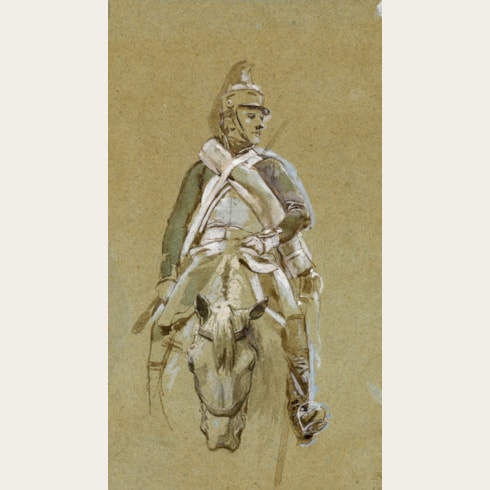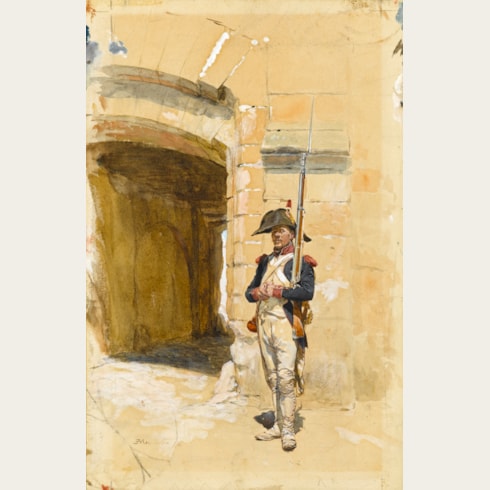Jean-Louis-Ernest MEISSONIER
(Lyon 1815 - Paris 1891)
Venice: The Entrance to the Grand Canal, with Santa Maria della Salute and the Punta della Dogana seen from the Casa Fumagalli
Signed with the artist’s monogram EM and inscribed facendo questo disegno non fui mai più contento / ora, amica mia, accetatelo, è un ricordo di felice tempo at the lower right.
Dedicated and dated alla signora Elisabetta Bezanson / 1 Janvier 1887 on the verso.
Further inscribed en sepbre 1886 = au bas de [word missing] demeure = Casa Fumagalli = 2 entrées une sur le [word(s) missing] on a strip of brown paper pasted onto the reverse of the old frame.
190 x 303 mm. (7 1/2 x 11 7/8 in.)
Drawn in 1886 and dedicated to the artist’s future second wife, this watercolour shows the view of the Grand Canal from the entrance to the Casa Fumagalli, where Meissonier stayed when he was in Venice6. It can be closely related to the later canvas of The Grand Canal, Venice, painted two years later in 1888 and today in the Musée d’Orsay in Paris. As Valéry Gréard has described the composition of the large painting, in his magisterial monograph on Meissonier, published in 1897: ‘Grand Canal, Venice. View from the entrance of the Casa Fumagalli, occupied by Meissoner. His gondola (with an awning) waits at the steps; other gondoliers hang about for customers. On the post a figure of the Virgin, where a lamp burns at night. A gondola crosses the canal towards the Dogana; on the left, the Church of the Salute and the pink buildings of the Seminary; the masts of ships in the Giudecca beyond.’ A closely related watercolour of the same view, which is closer in composition to the final painting and is likely to date from 1888, is in the Louvre.
The present sheet bears a dedication to the artist’s second wife, Elisabeth Bezanson (1840-1898), his neighbour in Poissy and a close friend, whom he married in Paris in July 1889. The dedication may be trasnlated as ‘I was never more content than when working on this drawing, therefore, dear friend, accept it as a memento of happy hours.’
‘The incontestible master of our epoch’, as Eugène Delacroix described him, gives some indication of the esteem in which Ernest Meisonnier was held by his contemporaries, critics and the public. Enjoying a career of more than fifty years, he was one of the most famous painters of the 19th century, renowned both in France and abroad. Largely self-taught as an artist, he began his career as a designer of wood engravings for book illustrations. Although he exhibited paintings regularly at the Salon from 1834 onwards, winning several medals in later years, Meissonier’s first taste of international fame came at the Exposition Universelle of 1855, when his painting of A Brawl was bought by Napoleon III as a present for Prince Albert of England. Much of his work was on a very small and intimate scale, and reveal the influence of the Dutch genre painters of the 17th century that he had studied as a young apprentice. His subject matter included scenes of 17th and 18th century life, as well as more contemporary depictions of men at leisure, all painted on small panels and executed with a meticulous attention to detail.
From the late 1840’s onwards Meissonier also devoted much of his time to military subjects, basing his paintings on drawings and oil sketches of soldiers, their horses, uniforms and equipment, mostly taken from life. From 1876 onwards Meissonier stopped exhibiting at the Salons, preferring instead to show his work in the annual exhibitions of the Cercle de l’Union Artistique. Meissonier enjoyed considerable financial success as a painter and was the first artist to be awarded the Grand Cross of the Legion of Honour. He also produced a small number of wax sculptures of horses, intended primarily as aids for his paintings and not cast or publicly exhibited until after his death.
Provenance
Literature






